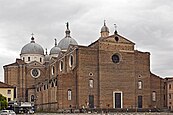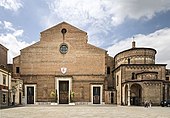
Back Padua Afrikaans Padua ALS Padua AN باذوة Arabic بادوڤا ARZ Padua AST Padua Azerbaijani پادووا AZB Падуя Byelorussian Падуя BE-X-OLD
This article needs additional citations for verification. (May 2009) |
Padua
| |
|---|---|
| Città di Padova | |
| Coordinates: 45°25′N 11°52′E / 45.417°N 11.867°E | |
| Country | Italy |
| Region | Veneto |
| Province | Padua (PD) |
| Frazioni | Altichiero, Arcella, Bassanello, Brusegana, Camin, Chiesanuova, Forcellini, Guizza, Mandria, Montà, Mortise, Paltana, Ponte di Brenta, Ponterotto, Pontevigodarzere, Sacra Famiglia, Salboro, Stanga, Terranegra, Volta Brusegana |
| Government | |
| • Mayor | Sergio Giordani (PD) |
| Area | |
| • Total | 92.85 km2 (35.85 sq mi) |
| Elevation | 12 m (39 ft) |
| Population (31 October 2011)[2] | |
| • Total | 214,125 |
| • Density | 2,300/km2 (6,000/sq mi) |
| Demonym(s) | Padovano Patavino |
| Time zone | UTC+1 (CET) |
| • Summer (DST) | UTC+2 (CEST) |
| Postal code | 35100 |
| Dialing code | 049 |
| Patron saint | Saint Anthony of Padua |
| Saint day | June 13 |
| Website | www |

Padua (/ˈpædjuə/ PAD-ew-ə; Italian: Padova [ˈpaːdova] ; Venetian: Pàdova, Pàdoa or Pàoa) is a city and comune (municipality) in Veneto, northern Italy, and the capital of the province of Padua. The city lies on the banks of the river Bacchiglione, 40 kilometres (25 miles) west of Venice and 29 km (18 miles) southeast of Vicenza, and has a population of 214,000 (as of 2011[update]). It is also the economic and communications hub of the area. Padua is sometimes included, with Venice and Treviso, in the Padua-Treviso-Venice Metropolitan Area (PATREVE) which has a population of around 2,600,000.
Besides the Bacchiglione, the Brenta River, which once ran through the city, still touches the northern districts. Its agricultural setting is the Venetian Plain. To the city's south west lies the Euganaean Hills, which feature in poems by Lucan, Martial, Petrarch, Ugo Foscolo, and Percy Bysshe Shelley.
Padua has two UNESCO World Heritage List entries: its Botanical Garden, which is the world's oldest, and its 14th-century frescoes, situated in buildings in the city centre.[3] An example is the Scrovegni Chapel painted by Giotto at the beginning of 1300.
Padua is home to one of the oldest universities in the world, the University of Padua, founded in 1222 and where figures such as Galileo Galilei and Nicolaus Copernicus taught or studied. In 1610, Galileo observed the moons of Jupiter through a homemade telescope in Padua, marking the second phase of the Copernican Revolution. Today, the university has around 72,000 students and has a profound impact on the city's recreational, artistic and economic activities.
- ^ "Superficie di Comuni Province e Regioni italiane al 9 ottobre 2011". Italian National Institute of Statistics. Retrieved 16 March 2019.
- ^ "Popolazione Residente al 1° Gennaio 2018". Italian National Institute of Statistics. Retrieved 16 March 2019.
- ^ Padova Urbs Picta. "Padova Urbs Picta, UNESCO candidacy". Padova Urbs Picta. Retrieved 15 August 2021.











